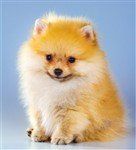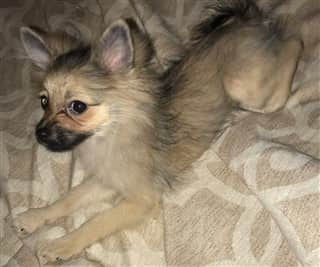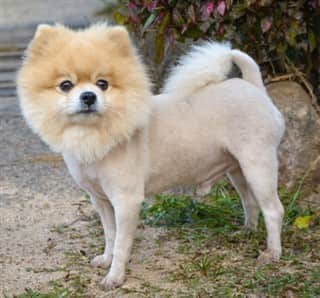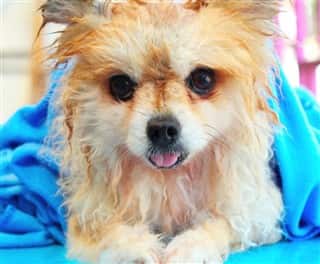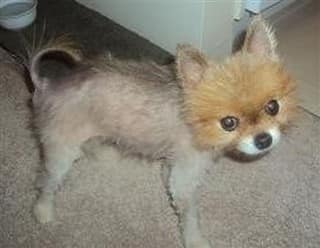Pomeranian Hair Growth
Overview
A Pomeranian’s thick double-coat of fur is one of their most defining features. Ideally, it will be tightly packed, thick, strong, and soft to the touch. But a Pomeranian’s fur may not always look or feel perfect; there are times when it may appear sparse or have trouble growing. And the coat may have poor texture, looking dry and dull.
This section will cover many aspects related to helping grow the coat and maintaining good coat health, including:
- Understanding the two layers of a Pomeranian’s coat
- Shedding and continual regrowth summary
- Top 5 reasons for coat issues
- How to promote hair growth
So, let’s dive into the details so that your Pom’s coat will be on its way to looking full and healthy.
Please note:
PetPom is reader-supported, and some of the product suggestions on this page are affiliate links. As an Amazon Associate we earn from qualifying purchases. This is at no extra cost to you and helps us continue providing free, high-quality information.
Understanding the Two Layers of a Pomeranian’s Coat
Moving forward, it will help to understand the anatomy of a Pomeranian’s coat.
There are two layers.
The inner layer,
also known as the undercoat, is short, tightly packed, soft fur that provides warmth in the winter and helps keep a dog cool in the summer (it acts as a barrier to the sun and heat).
When a Pom sheds, most of the shedding is coming from this layer, so not all hairs will fall to the floor; many will become trapped in the coat.
There needs to be a fine balance with the undercoat. If dead hairs are not pulled out, it can get too packed, blocking airflow and causing smells due to body oils clinging to the dead hairs. And if this was inadvertently thinned out (live hairs removed), it can take a long time for it to grow back in and there may not be enough support for the outer coat to stand as it should.
The outer layer
is comprised of long guard hairs. These have a bit of a coarser texture but by no means should feel dry or rough. When the coat is in good shape, these hairs will stand out to a certain degree, creating a nice full look.
Though the outer hairs can be trimmed to give a Pomeranian a nice neat appearance (most Poms in conformation show events have their outer hairs layered), these should never all be cut away and certainly never so much that the inner layer is touched.
Shedding and Continual Regrowth Summary
Another element to know about is how a Pomeranian’s coat refreshes and renews.
For adult Poms, there is light to moderate shedding year-round and a heavy shed at least once a year (early spring). This type of shedding mainly affects the undercoat. Proper brushing techniques and steps to ensure coat health will help this recurrent process.
However, the outer coat of longer hairs also goes through a natural cycle of growth, rest, and fall (much like your own hair). If new hairs are not able to grow in to keep up with hairs that have fallen out, the coat will look sparse and thinned.
Top 5 Reasons for Coat Issues
#1 The puppy uglies.
This is Bailee, a 5-month-old Pom puppy with a very severe case of the puppy uglies
with lots of thinning patches. Photo courtesy of Britanee
Though this is a normal phase for the Pomeranian breed, and not technically an issue per se, it causes such concern for unprepared owners that it must be listed. This refers to the stage when puppy hair falls out and the adult coat grows in, which typically starts at the 4 to 6-month mark and is complete approximately by the 12 to 15-month mark (and in some cases, the 24-month mark).
'
Pomeranian puppies are born with just one layer of fur; it is relatively short and as soft as a feather. As the pup matures, the two-layer adult coat will grow in. During this phase, the soft puppy hair can fall out much faster than the adult hairs are growing in.
The coat can look the complete opposite of what you would expect with this breed and the pup may look very odd. The entire coat may look sparse or thinned out. There can be sections of super short hair and patches of long hairs randomly sticking out making it look very uneven.
Though much of the coat transformation process will happen naturally and all you really need is patience, there are some steps you can take to maintain overall good coat health and prompt hair growth of the adult coat to help speed things along. Both of these elements are coming up ahead.
#2 Bad grooming experience.
This poor little Pom had their entire body shaved, essentially down to the skin,
and only fur on the face and tail remain. This is known as a lion cut
and should never be done if you want your Pom to have a nice fluffy coat in the future.
This little gal hardly even resembles a Pomeranian any more.
The coat has been destroyed by the outer layer being completely cut off
and the inner layer being shaved into.
One of the top reasons for an owner’s sudden panic about their Pom’s fur is a ‘grooming gone wrong’ incident. Sadly, this is common. We receive several emails a week from people who took their Pomeranian to the groomer only to pick up their dog to see that the coat was destroyed.
In some cases, it’s a matter of a groomer getting carried away; an owner asks for a trim to tidy things up and the groomer goes way overboard by cutting off all the long outer guard hairs and shaving the Pomeranian down. Understandably, it can be horrifying to suddenly see a Pomeranian with their beautiful coat gone.
In other cases, an owner may unknowingly request a ‘summer cut’, ‘lion cut’ or otherwise ask that the coat be shaved only to later learn that this should not be done with Pomeranians.
You would assume that professional groomers would know better, however once the entire outer coat is removed and especially if the inner coat is cut into, the coat may struggle to grow back as it once was. Hair growth may be very slow and/or it may be very uneven.
Fortunately, there are some steps you can take to help a Pomeranian’s hair grow back, even if it was damaged by a groomer.
#3 Damage via coat products.
The pet supply market is flooded with inferior coat products, including shampoo and condition, that have formulas that can be detrimental to a dog’s coat:
- Incorrect pH levels. Levels between 4 to 5.5 can strip hair cuticles causing frizz, split ends, inability to retain moisture, and poor hair growth (long hairs will be snapping off so fast that new hairs will struggle to keep up).
- Soaping agents. You might assume shampoo should have soap; however, sodium laureth sulfate (SLES), sodium lauryl sulfate (SLS), and ammonium lauryl sulfate (ALS) can cause dry, irritated skin which affects hair follicles and in turn hair growth.
- Other additives. Parabens, phthalates, synthetic fragrances, and coloring dyes can cause excessive hair dryness, skin irritations, or even allergic reactions.
#4 Nutritional deficiency.
There are several nutrients that have a direct effect on a dog’s coat health and hair growth.
- Protein. Keratin is a key structural protein of dog fur (and nails), formed from amino acids found in protein. If there are not enough amino acids, a dog’s keratin levels will drop, and hair growth can dramatically slow down.
- Biotin. This compound is linked to the amino acids that promote hair growth. Some foods that dogs can eat that contain biotin include egg yolks, organ meat, salmon, sweet potatoes, and lentils.
- Iron. It is iron that brings nourishing oxygen to hair follicles and low levels of iron are connected to excessive shedding and slow coat growth. Foods that dogs can eat that contain good levels of iron include spinach, beef, tuna, and eggs.
- Omega-3 fatty acids. This is perhaps the most important nutrient in regard to keeping the skin and coat healthy and helping a Pomeranian grow their hair back nice and full. Omega-3 is found in foods like fish and flaxseeds.
#5 Health issues.
This is Mercedes, when she was diagnosed with Alopecia X
(though it was highly suspected that she had BSD due to black skin
previously all over her body that sloughed off during baths).
Photo courtesy of Shirl T.
While not overly common, there are some health issues that can affect a Pomeranian’s coat. When other reasons are not applicable or treatments are not working, these issues should be ruled out:
- Parasites. This includes demodectic mange; signs include fur loss around the eye area, trunk, and/or legs and/or skin lesions on balding areas with or without crusting. Ringworm is another possibility; signs include circular bald spots.
- Hypothyroidism. When the thyroid is under-producing, signs can include dry and brittle fur.
- Stress-induced fur loss called telogen effluvium. Extreme stress can trigger hair follicles to enter an extended resting phase. Two to three months later, there can be a sudden shedding of those hairs.
- Canine diabetes. Other signs are usually more obvious such as increased thirst, lethargy, and weight changes; however, may also involve a thinning or dull coat.
- Cushing’s disease. This disease that affects cortisol levels is more common with dogs age 6 and up. Signs include thinning coat, as well as easy bruising, increased thirst, increased urination, and lethargy.
- Folliculitis. This is an infection of the hair follicles that can lead to thinning and then balding spots.
- Alopecia X or Black Skin Disease. Alopecia X refers to coat loss with unknown causes, though there may be a link to hormones. Black Skin Disease is similar, though is the term given when a dog’s skin turns black. Treatment for Poms with Alopecia and BSD often overlap.
How to Promote Hair Growth
Whether your Pom is going through the puppy uglies
and you want to help the process along, a groomer ruined your Pomeranian’s coat by shaving it, or years of bad coat products have led to terrible damage, you’ll be happy to know that there are some steps you can take that can help improve coat health and prompt the fur to growth back in.
Do note that this sort of thing takes time and commitment. You need to be dedicated to the process and be patient. In addition, it would be very rare for just one of these steps to trigger a Pomeranian’s coat to grow fast; rather, it is the combination of these elements that will bring about the most success.
#1 Brush the coat on a regular basis.
There are 3 reasons to brush often:
- To remove dead hairs that can otherwise block airflow and (due to becoming encased with body oil) clog hair follicles.
- To remove loose hairs before they fall and become trapped in the coat. This expedites the process and makes room for new hairs.
- To stimulate hair follicles.
It is vital to use the right brush and grooming tool
for this; the wrong type, like a spinning grooming rake that pulls out live hairs, can utterly destroy the coat and a soft bristle brush will just glide over the hairs and won’t have any effect.
We recommend a small bubble-tipped slicker brush like the PetPawJoy Slicker Brush . The brush head rotates so it’s easy to keep brushing in the direction of fur growth, it is sized ideally, it has a great grip, and the massaging bubble-tips get the job done while preventing discomfort or skin irritations.
. The brush head rotates so it’s easy to keep brushing in the direction of fur growth, it is sized ideally, it has a great grip, and the massaging bubble-tips get the job done while preventing discomfort or skin irritations.
Note:
Brush your Pom 2 to 3 times a week and never brush a dry coat (see next tip).
#2 Use a leave-in conditioner.
There are many reasons to use a leave-in product when you’re trying to help a Pomeranian grow their fur back:
- When misted on during brushing, it allows the brush to glide and helps prevent hair from snagging
- Helps prevent static and split ends
- Offers a layer of protection against contact friction
- Helps the coat repel irritants and debris
- Helps protect from UV exposure
- Helps hairs retain natural moisture levels
- As an added bonus can offer a nice clean scent
The type that you use may depend on the season. In the summertime when UV rays can dry out fur but also can cause sunburn to a Pom with a short, shaved coat (should that be the case), Chris Christensen Ice on Ice with Sunscreen
 can be a good choice.
can be a good choice.
The rest of the year (or year-round if your Pom is not outside that often), a spritz like The Stuff Leave-in Conditioner
 can work very well as a protectant, repellent, conditioner, and detangler.
can work very well as a protectant, repellent, conditioner, and detangler.
#3 Massage in a restorative cream.
When the coat is very damaged and you’re desperate to trigger hairs to grow back, it can be very helpful to massage a cream or lotion into a Pom’s skin and hair roots. Just the act of massaging alone can work well to stimulate hair follicles. And if you use something with restorative and moisturizing ingredients, you can really give the skin and fur a boost.
For severe coat issues, the best results have been seen when the following instructions are followed:
- Massage in 2 times each day for 7 straight days, for at least 5 minutes.
- Then, massage in 1 time each day.
- Once you start to see that hairs are growing back in and the coat is getting fuller, continue to use every other day for at least 3 weeks.
In most cases, the cream can then be discontinued if you are following the other tips.
For this, we recommend ResQ Organics Pet Skin Treatment
 which has a nutrient-rich blend of organic aloe vera, Manuka honey, coconut oil, shea butter, and amino acids that is excellent for both skin and fur health.
which has a nutrient-rich blend of organic aloe vera, Manuka honey, coconut oil, shea butter, and amino acids that is excellent for both skin and fur health.
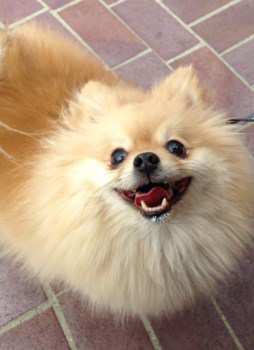
A nice, healthy coat!
Pooh Bear, 4 years old, photo courtesy of John & Wendy Traynor
#4 Use a nourishing shampoo & conditioner.
While you always want to use quality products, if a Pom’s fur has undergone extreme thinning or has been shaved down too short, it’s more important than ever to avoid detrimental ingredients like harsh soaping agents, heavy fragrances, and parabens, phthalates, and other drying elements.
A formula with plant-based cleansers (coconut is great), a pH level between 6 and 7, and moisturizing and restorative ingredients like aloe, tea tree oil, shea butter, and/or oatmeal is best. We recommend Earthbath Oatmeal & Aloe Shampoo . If you are massaging in a restorative cream (tip #3), you can continue to bathe your Pom just once every 3 weeks.
. If you are massaging in a restorative cream (tip #3), you can continue to bathe your Pom just once every 3 weeks.
And, never skip a conditioner. No matter which shampoo you use, the bathing process causes hair follicles to open. A wash-out conditioner is required to soothe them down and close them. Without this, hairs will be terribly vulnerable to just about everything and can become damaged within the day. For this, we recommend Earthbath Oatmeal & Aloe Rinse & Conditioner .
.
Note:
Never ever rub the coat dry. If hairs are long, this can cause immediate tangles and mats that can destroy the coat. And if hairs are short this can cause split ends. Always dab and blot, not rub.
#5 Omega-3 fatty acids supplements.
As discussed early, there are several nutrients that affect fur growth and omega-3 is the most notable one. Offering extra omega-3 can go a long way in restoring fur health and triggering new hairs to grow back in.
The most effective type of omega-3 is EPA and DHA which is sourced from fish. And, of the choices between wild and farmed fish, wild fish is usually the best bet since farmed fish may be fed fish pellets that contain vegetable oil that can interfere with omega-3 levels.
For this, we recommend Zesty Paws Pure Wild Alaskan Salmon Oil
 which is a liquid supplement that just about every Pomeranian finds to be super-delicious and it comes in a pump that makes it easy to dispense into meals (be sure to mix well).
which is a liquid supplement that just about every Pomeranian finds to be super-delicious and it comes in a pump that makes it easy to dispense into meals (be sure to mix well).
#6 Melatonin; optional and should be done under vet supervision.
In severe cases of hair loss, particularly when alopecia or BSD is suspected or known, melatonin can sometimes produce hair growth results when used in conjunction with the other methods listed here.
Though this is an over-the-counter product, it is recommended to obtain your vet’s approval since this can cause side effects such as sleepiness (it is sometimes used as a sleep aid or anti-anxiety aid), it can interfere with some medications, and some dogs with certain health conditions should not be given melatonin.
Dosing for dogs under 10 pounds is typically 1 mg per day, given orally at night for a minimum of 3 months and until hair growth seems to have plateaued. It may then either be tapered off or continued at a low-dose. When treating BSD or alopecia, indefinite use is sometimes the choice because if it is discontinued and fur falls out again, there may be a lackluster response a second time.
If your vet does give you the ‘okay’, a supplement like Nature's Bounty 1 mg Melatonin
 that comes in 1 mg tablets can be a good choice.
that comes in 1 mg tablets can be a good choice.
Summary of Hair Growth Tips
When you’re really worried about your Pomeranian’s coat and are looking for fast and effective ways to get the hair to grow back, things can seem overwhelming. However, once it’s broken down, it's very doable. Let’s take a look at the 6 steps to help a Pomeranian re-grow their fur:
- Brush the coat 2 to 3 times a week with a bubble-tipped slicker brush.
- Use a leave-in coat conditioner when you brush.
- Massage in a restorative cream. For severe issues, start off doing this twice per day for one week.
- Bathe your Pom with a nourishing shampoo and then use a wash-out conditioner. Always dab and blot to dry the coat, never rub it with a towel.
- Offer omega-3 EPA and DHA via a liquid fish oil supplement.
- For severe cases (such as balding), speak to the vet about offering OTC melatonin.
Related Articles:
The Best Shampoos for Pomeranians
- A list of the top picks for regular shampoo and for specialty products to help treat common issues.
Pomeranian Skin Conditions
- A summary of the most common skin issues. Covers good grooming practices and steps to keep skin healthy.
Pomeranian Grooming
- An overview of the various tasks that are involved with grooming a Pom puppy or adult dog.
How to Keep a Pomeranian Clean
- Super helpful tips for keeping a Pom looking tidy and smelling nice.
Are you part of the PetPom family?
Please join us and Become a Free PetPom Member
to receive a reminder when we add new articles to the site, hold yearly events like the Pomeranian Halloween contest, and more.
More Reading:
Pomeranian Summer Care Tips
- The long hot summer can be a tricky time to take care of a Pomeranian, a Spitz breed with a thick double-coat. See our top tips to help a Pom have a fun and comfortable season.
Pomeranian Winter Care Tips
- Read about the common problems owners encounters in the wintertime and how to make it a great season for your Pom puppy or adult dog.

